Microsoft Surface 2 Review
by Anand Lal Shimpi on October 21, 2013 12:00 AM EST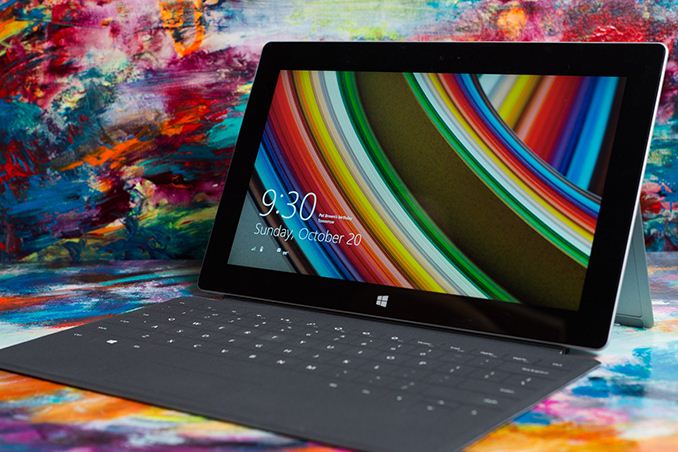
A year ago Microsoft first threw its hat into the tablet race with a new brand, a new OS and a completely new strategy. To make a challenging situation even more difficult, Microsoft chose to go after the traditional tablet market with a device that was neither a tablet nor a notebook.
I was relatively pleased with both Surface devices that launched last year. Surface RT had potential, but it was too slow, needed a price adjustment and of course needed more maturity on the OS side. Surface Pro on the other hand needed to be thinner, needed Haswell and related, it needed better battery life.
With its new commitment to being a devices & services company, Microsoft now joins the ranks of Apple and Google in shipping platforms with annual updates to hardware and software. Last week we saw the software side of the story, with a free update to Windows 8.1. It wasn’t too long ago that Microsoft was charging hundreds of dollars for new OS revisions, but with Apple and Google redefining what users come to expect from both cost and frequency of OS updates, Microsoft had to change.
Today we get the second half of the story. Microsoft’s partners have already announced their Windows 8.1 launch devices, now it’s time for Microsoft.
I’ll start with Surface 2, which sees the largest number of physical changes compared to its predecessor. It’s still built using the same injection molded magnesium manufacturing process (VaporMg, pronounced vapor mag), but moves to a 2-piece VaporMg design similar to Surface Pro. There’s the VaporMg tub and the kickstand.
The look and feel of the device see substantial updates. The finish of Surface 2 is now a light silver. Not only does the new finish not pick up grease/fingerprints like the previous black finish, but it also has a slightly more textured feel to it. Staring at Surface 2’s display head on you get a little bit of a silver border around the display, a nice touch. Surface 2’s construction feels every bit as solid and expensive as its predecessor. Both devices remain the absolute best built Windows tablets/notebooks on the market.
Curiously enough both Surface 2 and Surface Pro 2 ditch the Windows 8 logo on the back of the kickstand in favor of a Surface logo. The devices in general continue to be devoid of excess branding. Both have a capacitive Windows button up front, the aforementioned Surface logo around back and some branding on their respective chargers. There are no stickers to remove, and no COA labels to worry about. It may be years later than we’d hoped, but Microsoft finally gets the beauty of clean aesthetics.
The overall dimensions of Surface 2 don’t change much compared to its predecessor. We’re still dealing with the same 10.6-inch display size, although it sees an update to a 1080p panel with improved color accuracy. The panel size determines the overall device footprint, which explains why that doesn’t change this round. Thickness goes down a small amount from 0.37-inches to 0.35. The reduction is very subtle but helps contribute to the device feeling more right in hand.
Weight improves slightly if you compare Surface 2 to Surface RT. While the latter weighed in at 1.5 lbs, Microsoft lists Surface 2 as weighing less than 1.49 lbs. The somewhat vague spec is designed to take into account variations in manufacturing. Microsoft encouraged me to weigh my Surface 2 review sample, which came in at 1.45 lbs compared to a flat 1.50 lbs for Surface RT. It’s a small difference, but a definite step in the right direction. If the rumors of a lighter iPad 5 are true however, I do wonder if Microsoft should’ve been a bit more aggressive on the weight reduction front this round.
Just as before, Microsoft stresses the importance of looking at weight distribution not just overall weight specifications. Truth be told, Surface 2 doesn’t feel as heavy as the iPad despite having very similar weight specs.
A big part of the Surface story is the device’s integrated kickstand. The best way to talk about the improvements to the kickstand in Surface 2 (and Surface Pro 2) is to quote what I said about the previous design:
“The more I use Surface (Pro and RT) the more I feel that Microsoft needs to pursue something a bit more flexible than the fixed 26-degree kickstand. The biggest issue by far is in-lap use with one of the keyboard covers attached. Depending on your seating position, the 26-degree angle that the kickstand opens at might be too small. Mechanically I don’t know the right solution for Microsoft but I do feel like for the kickstand to realize its true potential, it needs to be able to open and hold at multiple angles. It doesn’t necessarily need to have support for infinite angles, maybe even a few would work, but I do believe it’s necessary going forward.”
Well, wouldn’t you know, Microsoft listened. Surface 2 and Surface Pro 2 both feature a new, 2-stage kickstand. You still get the same solid action, same sound and even the same 24-degree opening angle, but now there’s a second stop in the kickstand’s travel at 40-degrees. The 2-stage design almost completely addresses my issues with the first generation of Surface tablets. While the 24-degree stop is perfect for desk use, the 40-degree stop is ideal for in-lap use. The second stop keeps me from having to strain my neck looking down at the display when I’m typing in cramped quarters (e.g. having to type out this review in the back of a car heading to an airport).
Moving between stops on the new kickstand feels natural, and the new kickstand feels every bit as robust as its predecessor.
I don’t know that Microsoft has perfected the design though. I could still use another stop (or two). Perhaps one at 15-degrees for the on-chest use case if I’m laying down with the tablet on my chest watching a movie. A real issue created by the 40-degree stop is now I need even more leg/thigh/lap-space to support the device. Since there’s no support to hold the display up until you get to the kickstand, you need to make sure that the kickstand has a place to rest when open at its widest angle. I don’t know the right mechanical solution to this concern, but I still feel like Microsoft has some more work ahead of it on the kickstand front.
Behind the kickstand is a repositioned microSD card slot. It’s now further away from the kickstand hinge.
The ports/buttons around the edges of Surface 2 haven’t really changed compared to Surface RT. On the left you’ll find volume up/down buttons (which are appreciably clickier compared to my Surface RT review sample), a headphone jack and one of two speaker ports. On the top right there’s a power/lock button. On the right side you’ll find the other speaker port, micro HDMI output and a USB 3.0 port (new for Surface 2, RT only supported USB 2.0). All of the Surface devices retain the same custom, magnetic power connector as before.
Along the bottom there’s a slightly updated accessory connector and channel for accepting Surface’s famed keyboard covers, as well as new accessories this round. All first generation Surface accessories are supported.
Both front and rear facing cameras get a big upgrade with Surface 2. Surface RT shipped with two 1.2MP cameras, while Surface 2 moves to a 3.5MP front facing camera and a 5MP rear facing camera.
Internally, the upgrades are even more substantial. NVIDIA’s Tegra 3 is out of the picture, replaced by a far faster Tegra 4 SoC. That’s four ARM Cortex A15 cores running at up to 1.7GHz (1.9GHz with only one core active), as well as a fifth power saver core that actually sees some use this time (more on this later).
WiFi remains dual-band 2-stream 802.11n on both Surface 2 and Surface Pro 2, although whatever peak performance issues plagued me on Surface RT seem to be resolved (I could hit 120Mbps max transfers over 5GHz 802.11n).
The tablet still ships with 2GB of memory, but now leverages a 64-bit wide memory interface. On the storage side the options are still 32GB or 64GB of eMMC.
| Microsoft Surface 2/RT Comparison | ||||||||
| Surface 2 | Surface RT | |||||||
| Dimensions | 10.81 x 6.79 x 0.35" | 10.81 x 6.77 x 0.37" | ||||||
| Display | 10.6-inch 1920 x 1080 w/ Improved Color Accuracy | 10.6-inch 1366 x 768 PLS | ||||||
| Weight | Less than 1.49 lbs | 1.5 lbs | ||||||
| Processor | NVIDIA Tegra 4 1.7GHz | NVIDIA Tegra 3 | ||||||
| Connectivity | 802.11n WiFi | 802.11n WiFi | ||||||
| Camera | 3.5MP front facing, 5MP rear facing | 1.2MP front facing, 1.2MP rear facing | ||||||
| Memory | 2GB | 2GB | ||||||
| Storage | 32GB or 64GB eMMC | 32GB or 64GB | ||||||
| Battery | 31.5 Wh | 31.5 Wh | ||||||
| Starting Price | $449 | $349 | ||||||
Battery capacity is still 31.5Wh and Surface 2 still ships with a 24W charger. Surface 2 will draw 10W at the wall while charging, the over-specced adapter is designed to be able to power the system at full load without impacting charge times.
On the software front, Surface 2 ships with Windows RT 8.1 and a full copy of Office 2013 RT Home & Student Edition. Pricing starts at $449 for a 32GB model, or $549 for the 64GB version. Touch and Type covers continue to be sold separately at $119 and $129, respectively.


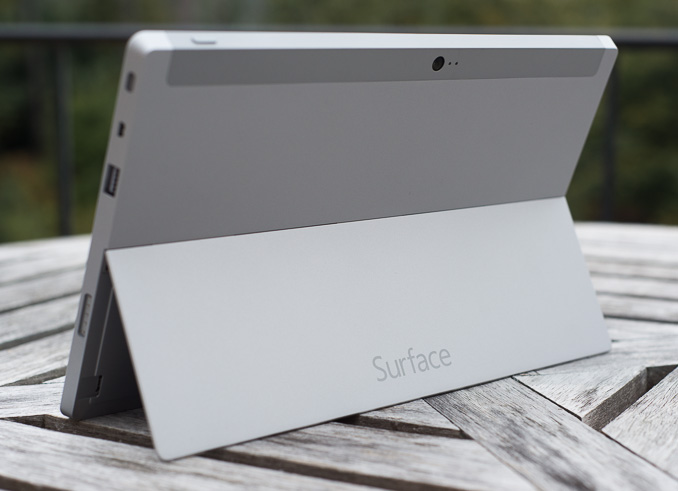
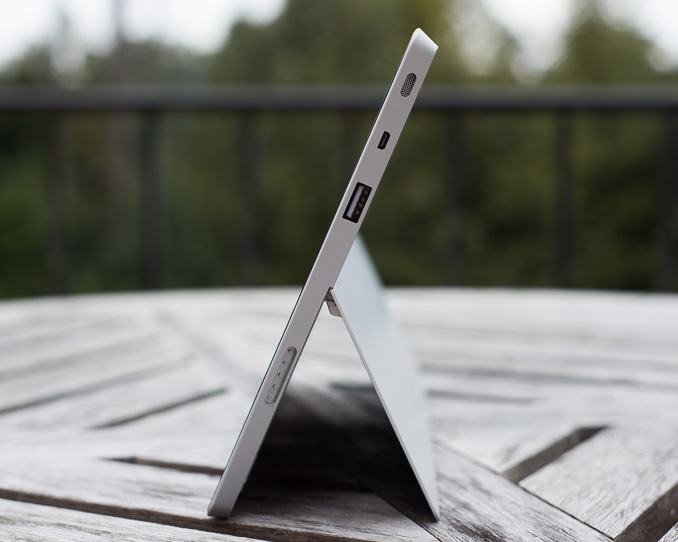
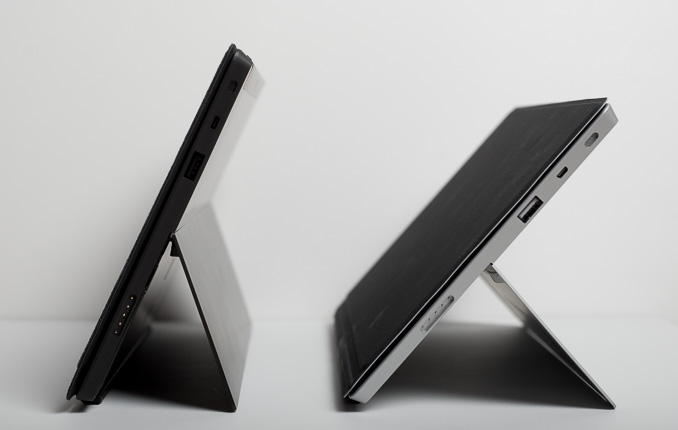
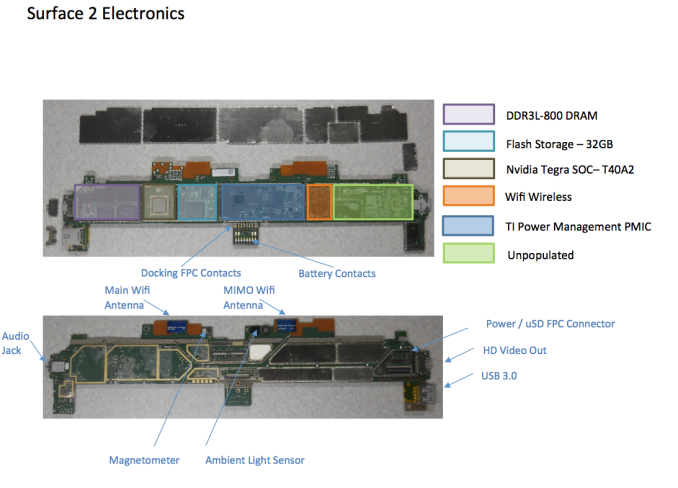








139 Comments
View All Comments
zepi - Monday, October 21, 2013 - link
I don't really see desktop as "being a side" in Windows 8.x. I see it actually existing solely because MS has not have enough time to create an adequate Office replacement for Modern UI. I wouldn't be surprised if it was removed completely once they have that sorted out.MS tried for more than a decade to bring touch to desktop. It has failed miserably, because it actually seems to be impossible while maintaining backwards compatibility with WIN32 GUI-components. They've come to a conclusion (that I share), that the only way to really bring touch to Windows is to bring it in separate to the desktop and start from a clean slate.
None of the successful modern touch-centric operating systems builds on top of WIMP paradigm or on top of legacy software developed for it. Mostly because WIMP just fundamentally seems to be incompatible with touchscreen (no pointer, no pixel-perfect clicks etc.) and I don't see MS being able to circumvent that. And they've seen it by themselves, so they created something new from scratch to actually make touch feasible. I see WinRT being out there because MS wants to enforce developers to create new versions of their UI's for Windows.
If developers won't create ModernUI version of Windows apps, Windows will die a slow death in consumer space within a decade or so. Only way to keep private people using Windows in this touch-screen (post-pc) era is to make using it as convenient and fun as with competing platforms. And for most people Windows desktop with desktop-apps is almost the exact opposite of fun and easy. It's all work and tedious managing of files, updates & anti-virus applications.
People seem to really enjoy using their touchscreen devices compared to regular computers. I guess it's mostly because interface to applications and data just seems so much more intuitive. In private life most of us just don't want to use computing devices. We just want to buy concert tickets, communicate with our friends, share our experiences of the every-day life and consume some entertainment. Some of us also enjoy creating stuff, but even then we just want the device to melt away between our vision and the end result. And allow for easy sharing of the end results.
G Davidson - Monday, October 21, 2013 - link
Very good post. The whole trouble with x86 windows is all the hassle of maintaining it. Half the time when I'm shutting down my laptop it takes 30 minutes to install various 'updates' that bring no benefit to me as a user other than protection from security flaws or hidden functionality for things I'll never be doing with it. That and the endless fiddling has no place on a tablet.The stark choice Windows faces in the consumer space is innovate to a usable paradigm or slowly die. Being the second or even third choice is equivalent to such a death for a company like Microsoft that produces little hardware.
Really a 'better' windows x86 tablet with new Atom processors is an attempt to resurrect the Netbook. Sure, many would love one to supplement their main PC, but it won't be much fun and will require lots of user maintenance, while still being too slow for heavy software designed for a 'real PC'. Hearing the graphics are low-powered makes it poor for gaming, too. Certainly, it would make for a great productivity device, except for photo and video editing that would be much slower on it.
Microsoft really need to make something like Windows RT that has specialized apps that work well on the low-powered base, stripping away the cobwebs of background processes and backwards compatibility with things their users don't need. If these same apps can work on mainstream Windows 8.1 etc, then all the better.
ESC2000 - Saturday, October 26, 2013 - link
So I assume you foresee such a bleak future for OSX as well?Really though all you're saying is that dealing with the interface and upkeep of a more powerful and capable OS is more complicated and effortful, which is not surprising....windows 8 and OSX are not as simple to handle as ios or Android but they also do a whole lot more. For some people the limited functionality of ARM tablet OSes may be sufficient, but for most I'd wager it's not if only because currently you can't even view more than one window at a time on ios/android devices (other than notes and surface RT). Even people who are not power users need to be able to view two things simultaneously.
Anyway I think it is way too early to predict the demise of microsoft. They see that the future is in one or maybe two devices that combine the functions of desktops, laptops, tablets, phones, gaming consoles, and possibly wearables. Windows 8 is their first stab at an OS that could work on such devices, and it will get better. Also tens of millions (hundreds of millions?) of consumers own devices with windows 8 and are growing accustomed to it despite its shortcomings. Most of them will continue to choose Windows machines bc of familiarity and cost. That's not to mention the MS's enterprise stronghold that is definitely not going anywhere (W8 is not so great on that front but the complete lack of alternatives makes Windows the only choice). They are also increasingly making hardware. What I'm saying is they are innovating by shifting away from the purely desktop paradigm and for a first attempt I think they've done a good job and exposed a lot of the market.
I am bullish about the future of MS and about the future of Google and Apple as well. I don't have some inscrutable hatred toward any of them the way many people on tech sites do against MS.
Braumin - Monday, October 21, 2013 - link
This looks like a great improvement over the Surface RT.I thought it was a good review, but Anand, you need to drop it with the Google stuff. You're comment "but in the case of a Chromebook you arguably have better integration of Google services" is of course true, but the Surface obviously has perfect integration with the Microsoft services, which, other than maps, are at least as good if not better.
And Google is the one to blame here they simply refuse to support any MS platforms anymore, which is too bad because I used to like and use Google services a lot. Now I just avoid them. Luckily I don't miss them.
And the Chromebook is WAY more limited in the applications it can run. Windows RT 8.1 is still a real OS unlike Chrome.
Anyway this looks great I'm happy to see the better display and better performance, plus the kickstand. I'd say MS fixed everything that they really needed to with regards to what they can achieve - obviously the substandard apps are something that hopefully will be fixed over time. It's a whole lot better than what it was a year ago that's for sure, but certainly not where I expected it to be. The Bing apps are amazing though which is a good start.
OoklaTheMok - Monday, October 21, 2013 - link
Yeah, I'm growing quite tired of the Chromebook talk. It's more restrictive than iOS, fewer apps than WebOS and most apps are just glorified web browser shortcuts. It doesn't even support multitasking... seriously? And some people want to talk it up like it's the bee's knees.AnandTechUser99 - Monday, October 21, 2013 - link
"There is an alternative solution to this entire problem however. I can’t help but feel like if Microsoft threw Intel’s Bay Trail in the Surface 2 chassis that a number of users might come to a completely different conclusion about the device. When we first posted about ASUS’ T100, common feedback was that users would be willing to pay more for an even better device. A Bay Trail Surface 2 could’ve been that device. "I couldn't agree more!
snajk138 - Monday, October 21, 2013 - link
They could do a Surface RT 2 with ARM, a Surface 2 with Atom and a Surface Pro 2 with Haswell.teiglin - Monday, October 21, 2013 - link
I'd love to see MSM8974 in the tablet performance charts--its absence is quite notable, and while the selection of 8974-toting Android tablets is pretty small now, it will only grow. If you think it'd be too weird to include Note 3/G2 results (I wouldn't mind), didn't you test Qualcomm's MDT? Not to mention, Bench doesn't even seem capable of doing the sort of comparisons I'd really like to see there.AmdInside - Monday, October 21, 2013 - link
I am going to buy this when I find a coupon that gets the Surface2 closer to $399. I think its a great iPad replacement for productivity. I actually wish it had Amazon services, not Google. Only Google service I would want is Google Chrome. I just am not a fan of IE11 as a desktop or tablet browser.flyingpants1 - Monday, October 21, 2013 - link
My single question for Anand: is there a single reason to get this over the Asus T100 for $349?